-

人教版高中英语必修5Making the news说课稿4篇
今天我们来介绍一下必修五第四单元的授课方式。这个单元的题目是Making the news。应该是学生比较感兴趣的话题,学生往往对新闻工作充满好奇,所以我们可以利用这个机会多设计一些师生互动和学生互动,来激发起学习的积极性,提高学习效率。同时我们可以利用这个单元不仅帮助学生掌握语言知识,培养语言能力,同时让其了解新闻工作的重要性,培养起社会智能感。这个单元分为六个课时,它的教学目标是这样的:语言目标是掌握词汇表中的常用单词和短语,掌握倒装句的一些基本用法。 技能目标是能初步掌握约会的基本句型并在真实的场景下正确运用。新闻报道类文章的写作技能。采访的基本规范和沟通技能。情感目标是对新闻报道的客观性和真实性有更好的理解。对新闻记者的职业有更深入的了解,并能体会其工作的重要性。下面我们来介绍一下第一课时的授课方式,第一课的教学目标是这样的第一课时的教学目标语言目标:单词:Occupation, journalist, editor, photographer, curious, personality, enthusiasm

人教版高中英语必修5The United Kingdom说课稿4篇
Teaching Aims:Knowledge 1. Get the students to learn the useful new words and expressions in this section. Aims:2. Let the students learn about how the UK was formed and the four groups of invaders.1. Develop students’ reading ability and let them learn different Ability reading skills. Aims:2. Enable students to learn to talk about the United Kingdom and the Union Jack Emotional 1. Let students know more about the UK2. Develop students’ sense of cooperative learning Aims:Teaching Important Points:1. Let the students learn about the countries of the United Kingdom and the Union Jack2. Get the students to read the passage and know about how the UK was formed and the four groups of invaders.3. Have the students learn different reading skills.Teaching Difficult Ponts:1. Develop students’ reading ability.2. Enable students to talk about the United Kingdom and the Union Jack.3. Let students learn how the UK was formed geographically and historically.Teaching Methods:Showing pictures, asking, exercising, listening, reading etc.Teaching Aids:A computer,a projector and a blackboard.Teaching Procedures: 1) Show a map of the world, ask students the following questions:Where is the UK?What’s the full name of the UK?2) Ask the students work in pairs to do the quiz on Page 9.Do you want to test how many things you know about the United Kingdom? Let’s have a small test.Using the map on P9, students answer the following questions:?How many countries does the UK consist of? What are they??England is divided into three main areas. Do you know what they are? 1) Scanning (10Minutes )Let the students hold the questions asked in pre-reading and read the passagequickly and then let them do the following exercise.Join lines to the right answer.
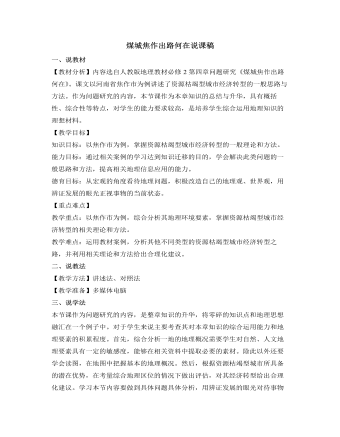
人教版高中地理必修2煤城焦作出路何在说课稿
分析过焦作市的地理概况和产业优势后,就需要针对由于资源枯竭所带来的问题提出合理化的建议。既然是谈经济转型,就应该将话题的范围明确在这一领域内。通过材料3的相关内容,我们了解到焦作市需要在产业结构调整、培育新的优势产业、增强综合竞争力等三个整改方针上下功夫。因而引导学生针对优势与不足提出建议,以三个整改方针为基准,衡量建议的可行性是锻炼学生解决此类问题的有效途径。在此我将教会学生的是解决问题方法而非案例的内容,正所谓“授之以鱼,不如授之以渔”。接下来针对学生的建议和教材资料分析所罗列的10点整改思路,由学生自由发言提出看法,通过教师的指导和学生的讨论,进而确定经济转型建议的具体方案。最后注意将建议与产业优势相对照,看建议是否都是围绕着产业优势而提出的,这样做会加深学生的印象,通过建议和优势的对应关系,将不难找出此类问题的解题思路。
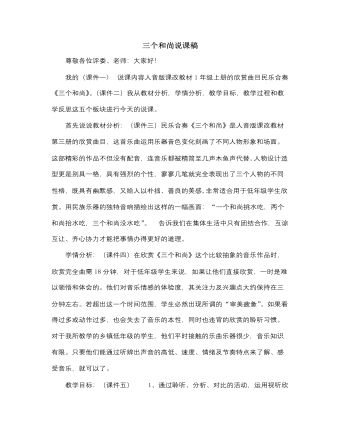
人音版小学音乐一年级上三个和尚说课稿
3.请几组同学表演这几个的场面,其他同学做评委,从模仿表演中享受学习音乐的快乐。五.课堂小结 (阶段目标:以“我的收获”(课件十)帮助学生总结所学内容,知道音乐中,不同的音乐要素可以表现不同的人物、场面)课后反思:(课件十一)在本节音乐欣赏教学中,我坚持以“听”为核心(因为音乐是一门听觉艺术),让学生“带着问题听”、“想着听”、“动着听”、“演着听”等多元化的“听”的形式。一系列“听”的任务不仅提高学生的注意力,而且提高学生“听”的兴趣与“听”的质量。而且我创造和谐的课堂气氛,积极引导学生把对音乐的内心感受大胆地用语言表达出来,让学生主动参与音乐快乐学习的实践中去,创建出有利于学生发展的生动活泼的音乐课堂情景,让学生的了解音乐,感受音乐,融入音乐。
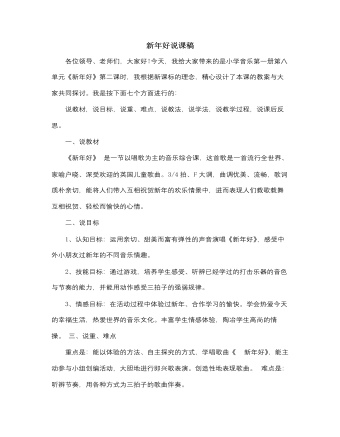
人音版小学音乐一年级上新年好说课稿
一、说教材《新年好》 是一节以唱歌为主的音乐综合课,这首歌是一首流行全世界、家喻户晓、深受欢迎的英国儿童歌曲。3/4拍、F大调,曲调优美、流畅,歌词质朴亲切,能将人们带入互相祝贺新年的欢乐情景中,进而表现人们载歌载舞互相祝贺、轻松而愉快的心情。二、说目标1、认知目标:运用亲切、甜美而富有弹性的声音演唱《新年好》,感受中外小朋友过新年的不同音乐情趣。2、技能目标:通过游戏,培养学生感受、听辨已经学过的打击乐器的音色与节奏的能力,并能用动作感受三拍子的强弱规律。3、情感目标:在活动过程中体验过新年、合作学习的愉快。学会热爱今天的幸福生活,热爱世界的音乐文化。丰富学生情感体验,陶冶学生高尚的情操。 三、说重、难点重点是:能以体验的方法、自主探究的方式,学唱歌曲《 新年好》,能主动参与小组创编活动,大胆地进行即兴歌表演。创造性地表现歌曲。 难点是:听辨节奏,用各种方式为三拍子的歌曲伴奏。
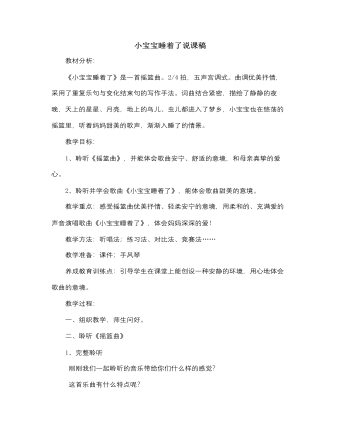
人音版小学音乐一年级下小宝宝睡着了说课稿
三、聆听、表演《小宝宝睡着了》 1、聆听歌曲启发学生说说听到歌曲时感受到了什么?2、复听,跟着歌曲,轻柔地拍节拍。 3、听琴声逐句学唱歌曲。 4、指导学生用连贯、轻柔的声音,唱准、唱好歌曲。 5、重点引导学生说说结尾的处理方式——对比练习,看哪一种方法更恰当 6、引导学生用自己创作的方式为歌曲伴奏、伴舞。 四、小结。 教学反思:一年级课堂上会有一些学生在上课的时候出现喊唱的现象,我在歌曲处理这一环节对歌曲的意境作了这样的描述:静静的夜晚,天上的星星睡了、月亮睡了、地上的鸟儿、虫儿也都进入了梦乡,小宝宝也在悠荡的摇篮里,听着妈妈甜美的歌声,渐渐入睡了。同学们妈妈哄宝宝睡觉唱歌的声音应该是欢快的,还是轻柔的?经过我的描绘和讲解学生理解了在演唱摇篮曲时应该用轻柔的声音,要把每一句都连贯的唱起来,不仅句与句之间要连贯,第一、第二段也要衔接紧凑,轻轻的哼唱出来,体会妈妈哄小宝宝睡觉时是多么的温柔。
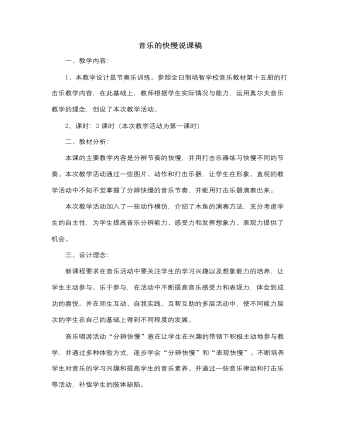
人音版小学音乐一年级下音乐的快慢说课稿
3、用木鱼来演奏音乐的不同节奏。(1)师:小动物们都能听着音乐按节奏走路了,下面我想考考你们能不能用这种乐器来演奏不同的节奏呢。(2) 出示木鱼,演示木鱼的演奏方法。师:左手拿木鱼,右手拿木棍,敲的时候要注意不要打在自己的手指上,打在手指上是没有声音的。(3) 玩游戏《听一听》,训练学生的听辨能力和记忆能力。师:我们先来玩一个游戏,老师敲出几个不同的节奏,你们听听哪个是最慢的,哪个是最快的,看谁的耳朵最灵敏。(4) 学生练习演奏木鱼,学会用木鱼敲出不同的节奏,教师个别指导。师:现在就请同学们自己来演奏木鱼,你可以尝试着怎样敲会快一点,怎样会慢一点。(木鱼学生人手一个)[设计思路]在分层教学过程中,由于个别学生的基础比较差,第一和第二段音乐的演奏训练还不能完全掌握,所以花的时间比较长。导致接下的第三和第四段音乐的木鱼节奏训练没有时间完成。我将在第二课时的复习巩固课上再让同学们来练习演奏。
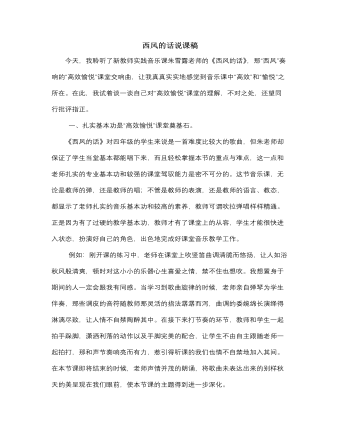
人音版小学音乐四年级下册西风的话说课稿
课堂上随机给出鼓励和肯定的语言更显教师的亲和力,营造出一个自由、民主的课堂教学氛围。如:“你很棒”“说得太好了”“掌声鼓励”等等,听似平淡无奇,但结合那时那景则显得老师语言的朴实与自然,学生同老师间的默契与和谐。听完朱老师执教的《西风的话》一课,通过认真反思我真切认识到:一堂好课是否愉悦高效,就看教师是否真正用心的地去诠释作品,真正用心地去备课。孙老师执教的《西风的话》平实、淡雅,教师教态自然大气,言谈中充满着激情,让我们的心不自觉跟着一起走。我想不出什么华丽的词藻来描述这堂课,但我却深深地被吸引,这应该就是生命课堂的魅力所在吧。听了孙老师执教的《西风的话》后收获很多,能于言表的也还没有表达充分,但更多的是带给我的触动和对自己所教学科如何“高效愉悦”的思索。也希望凭借着“高效愉悦”课堂活动的深入开展,让自己的美术课堂灵动起来,让我们的课堂真正成为孩子们探求知识的乐园。
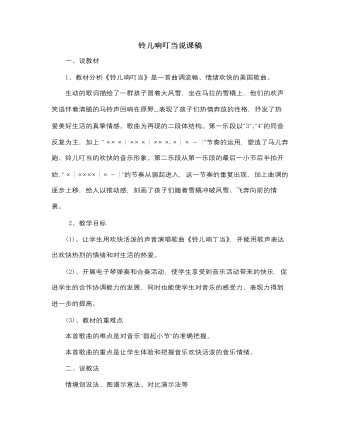
人音版小学音乐五年级下册铃儿响叮当说课稿
结合我们学校的教学条件和我自身会弹琴的优势,我还设计了课堂弹奏活动,激励学生练习好了参加圣诞联欢晚会给大家表演节目。 我把第一段的乐谱进行了简化节奏让学生弹奏,在弹奏基本完成后还设计了学生边唱边弹,并且分组让学生用电子琴自带的的打击乐器进行合奏练习,让学生在学唱的同时更加深入的体会音乐欢快活泼的节奏特点,同时让学生感受合奏的整体的音响效果,培养了学生的动手能力和集体合作能力。 六、总结 本课以歌曲《铃儿响叮当》为主要内容,听、唱、弹等教学环节都围绕他展开,各教学环节的设计易于统一,各项活动的设计均以音乐审美为核心,教学中关注段落的划分,注重引导学生的参与,体验,引导学生积极探索创造学习,展现音乐的节奏之美。
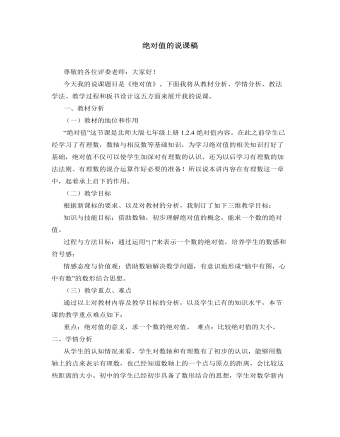
北师大初中数学七年级上册绝对值的说课稿
(三)学以致用,巩固新知为巩固本节的教学重点我再次给出三道问题: 1)绝对值是7的数有几个?各是什么?有没有绝对值是-2的数?2)绝对值是0的数有几个?各是什么? 3)绝对值小于3的整数一共有多少个?先让学生通过小组讨论得出结果,通过以上练习使学生在掌握知识的基础上达到灵活运用,形成一定的能力。(四)总结归纳,知识升华小结时我也将充分发挥学生学习的主动性,发挥教师在教学的启发引导作用,和学生一起合作把本节课所学的内容做一个小结。(五)布置作业,拓展新知布置作业不是目的,目的是使学生能够更好地掌握并运用本节课的内容。所以我会布置这样一个作业:请学生回家在父母的帮助下,找出南方和北方各三个城市的温度,并比较这些温度的大小,并写出每个温度的绝对值进行比较
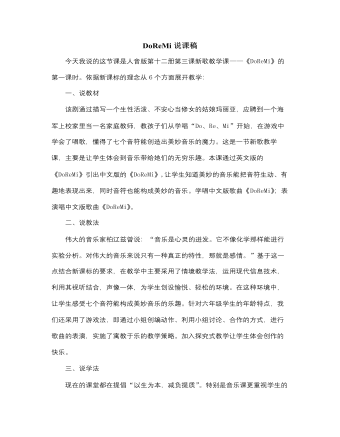
人音版小学音乐六年级下册DoReMi说课稿
1.通过欣赏《DO RE Mi》的影片,调动学生的积极性,增强学生学习新歌的兴趣。2.了解电影。任何一首歌曲都有着不一样的故事,通过文字简介,能够帮助学生深入歌曲的学习,升华表演的情绪。然后通过聆听歌曲《DO RE MI》,师范唱,生听唱,师指导唱的形式来帮助学生继续领略音乐的魅力。7.音乐游戏。不仅将学生分成七个小组跟琴演唱,还让学生根据伴奏完成歌曲接龙,充分体现了学生在课堂中的主体性。8.拓展开发。通过了解柯尔文手势,电影的背景资料和歌曲《孤独的牧羊人》的欣赏,提高学生的能力。第二环节既是这节课的重点,也是难点,通过引导学生运用手势音阶和肢体语言来表演歌曲《DoReMi》,又通过小组合作的方式突破难点。最后小结,简单地总结了同学们的表演让所有人感受到音乐带给我们的无穷乐趣,七个音乐字母构成了美妙的音乐,最后在美妙的音乐中结束了这节课!
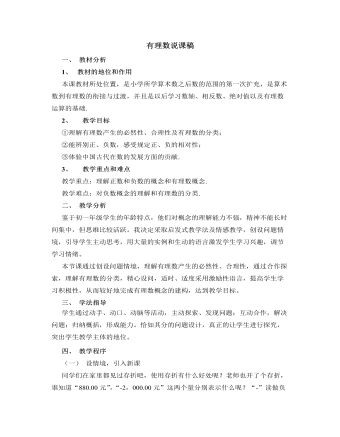
北师大初中数学七年级上册有理数说课稿
1、 教材的地位和作用本课教材所处位置,是小学所学算术数之后数的范围的第一次扩充,是算术数到有理数的衔接与过渡,并且是以后学习数轴、相反数、绝对值以及有理数运算的基础.2、 教学目标①理解有理数产生的必然性、合理性及有理数的分类;②能辨别正、负数,感受规定正、负的相对性;③体验中国古代在数的发展方面的贡献.3、 教学重点和难点教学重点:理解正数和负数的概念和有理数概念.教学难点:对负数概念的理解和有理数的分类.二、 教学分析鉴于初一年级学生的年龄特点,他们对概念的理解能力不强,精神不能长时间集中,但思维比较活跃。我决定采取启发式教学法及情感教学,创设问题情境,引导学生主动思考,用大量的实例和生动的语言激发学生学习兴趣,调节学习情绪。
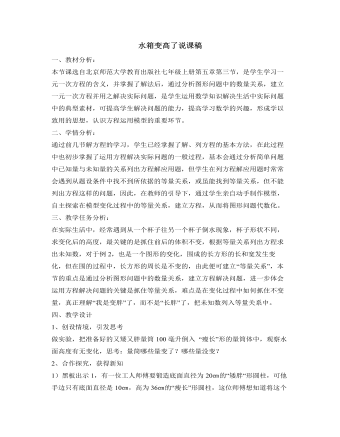
北师大初中数学七年级上册水箱变高了说课稿
一、教材分析:本节课选自北京师范大学教育出版社七年级上册第五章第三节,是学生学习一元一次方程的含义,并掌握了解法后,通过分析图形问题中的数量关系,建立一元一次方程并用之解决实际问题,是学生运用数学知识解决生活中实际问题中的典型素材,可提高学生解决问题的能力,提高学习数学的兴趣,形成学以致用的思想,认识方程运用模型的重要环节。二、学情分析:通过前几节解方程的学习,学生已经掌握了解、列方程的基本方法,在此过程中也初步掌握了运用方程解决实际问题的一般过程,基本会通过分析简单问题中已知量与未知量的关系列出方程解应用题,但学生在列方程解应用题时常常会遇到从题设条件中找不到所依据的等量关系,或虽能找到等量关系,但不能列出方程这样的问题,因此,在教师的引导下,通过学生亲自动手制作模型,自主探索在模型变化过程中的等量关系,建立方程,从而将图形问题代数化。
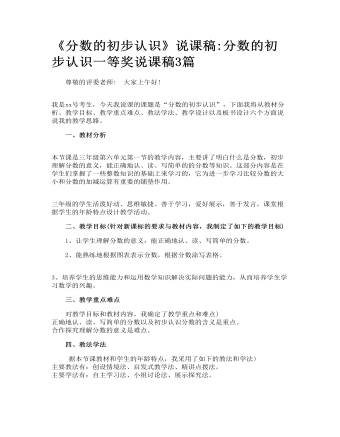
《分数的初步认识》说课稿_分数的初步认识一等奖说课稿3篇
一、教材分析? 本节课是三年级第六单元第一节的教学内容,主要讲了明白什么是分数,初步理解分数的意义,能正确地认、读、写简单的的分数等知识。这部分内容是在学生们掌握了一些整数知识的基础上来学习的,它为进一步学习比较分数的大小和分数的加减运算有重要的铺垫作用。? 三年级的学生活泼好动、思维敏捷、善于学习,爱好展示,善于发言,课堂根据学生的年龄特点设计教学活动。 二、教学目标(针对新课标的要求与教材内容,我制定了如下的教学目标)????? 1、让学生理解分数的意义,能正确地认、读、写简单的分数。????? 2、能熟练地根据图表表示分数,根据分数涂写表格。? 3、培养学生的思维能力和运用数学知识解决实际问题的能力,从而培养学生学习数学的兴趣。????? 三、教学重点难点 对教学目标和教材内容,我确定了教学重点和难点)???正确地认、读、写简单的分数以及初步认识分数的含义是重点。???合作探究理解分数的意义是难点。
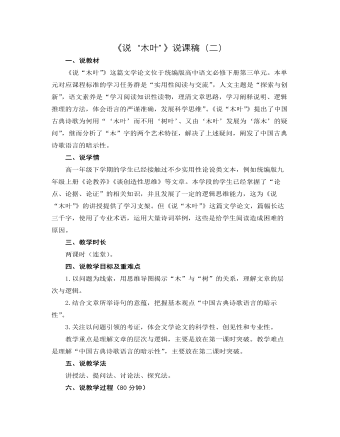
《说“木叶”》说课稿(二) 2021-2022学年统编版高中语文必修下册
一、说教材《说“木叶”》这篇文学论文位于统编版高中语文必修下册第三单元。本单元对应课程标准的学习任务群是“实用性阅读与交流”,人文主题是“探索与创新”,语文素养是“学习阅读知识性读物,理清文章思路,学习阐释说明、逻辑推理的方法,体会语言的严谨准确,发展科学思维”。《说“木叶”》提出了中国古典诗歌为何用“‘木叶’而不用‘树叶’、又由‘木叶’发展为‘落木’的疑问”,继而分析了“木”字的两个艺术特征,解决了上述疑问,阐发了中国古典诗歌语言的暗示性。二、说学情高一年级下学期的学生已经接触过不少实用性论说类文本,例如统编版九年级上册《论教养》《谈创造性思维》等文章。本学段的学生已经掌握了“论点、论据、论证”的相关知识,并且发展了一定的逻辑思维能力,这为《说“木叶”》的讲授提供了学习支架。但《说“木叶”》这篇文学论文,篇幅长达三千字,使用了专业术语,运用大量诗词举例,这些是给学生阅读造成困难的原因。
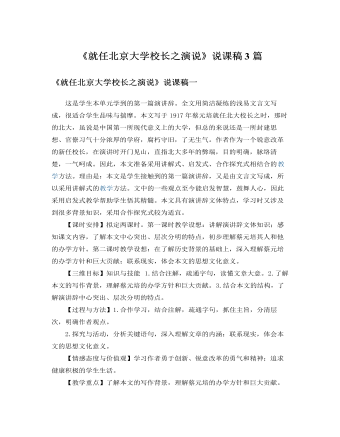
人教版高中语文必修2《就任北京大学校长之演说》说课稿3篇
(三)教学重、难点1、教学重点:结合课文,了解演讲辞针对性强、条理清楚、通俗易懂、适当的感情色彩等特点。2、教学难点:深入理解文章内涵,联系现实,体会本文的现实意义二、说学情高中学生在初中阶段已经接触过演讲辞了,对演讲词的特点已经有了一些基本的知识,因此本轮的教学应该让他们在此基础上有所提高。本文是学生在高中阶段第一次接触演讲辞,有必要让他们了解演讲辞的特点及课文如何体现这些特点的。随着年龄的增长,生活阅历的增加,高中学生正逐渐形成自己对世界、对人生的看法,蔡元培先生的这篇文章能很好地激发他们对当前的高中学习和未来的大学生活进行思考。此外,学生对北大的历史及蔡元培先生作这番演讲的时代背景了解不深,应作出补充说明。
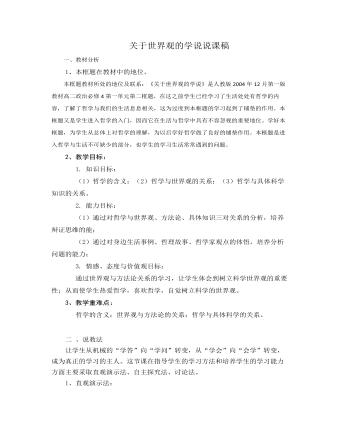
人教版高中政治必修4关于世界观的学说说课稿(二)
一、教材分析1、本框题在教材中的地位。本框题教材所处的地位及联系:《关于世界观的学说》是人教版2004年12月第一版教材高二政治必修4第一单元第二框题,在这之前学生已经学习了生活处处有哲学的内容,了解了哲学与我们的生活息息相关,这为过度到本框题的学习起到了铺垫的作用。本框题又是学生进入哲学的入门,因而它在生活与哲学中具有不容忽视的重要地位。学好本框题,为学生从总体上对哲学的理解,为以后学好哲学做了良好的铺垫作用。本框题是进入哲学与生活不可缺少的部分,也学生的学习生活常常遇到的问题。2、教学目标:1. 知识目标:(1)哲学的含义;(2)哲学与世界观的关系;(3)哲学与具体科学知识的关系。2. 能力目标:(1)通过对哲学与世界观、方法论、具体知识三对关系的分析,培养辩证思维的能;(2)通过对身边生活事例、哲理故事、哲学家观点的体悟,培养分析问题的能力;
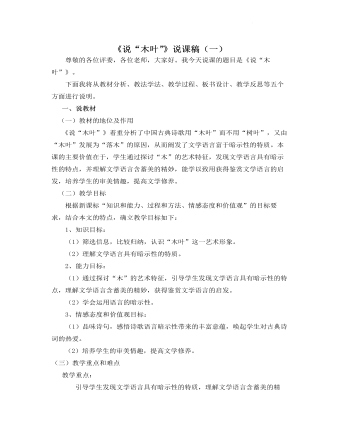
《说“木叶”》说课稿(一) 2021-2022学年统编版高中语文必修下册
这五个问题,主要从学情出发,由浅入深,从感知到理论,培养学生的鉴赏能力。第三环节:延伸探究、展示成果(多媒体显示)走出文本,引入课外同类文学现象,让学生能够触类旁通,举一反三,把教材作为一个例子,让学生在深入的文学鉴赏中再次获得语言的审美。同学们初步掌握了文学语言具有暗示性的性质后,还需巩固、提升鉴赏能力!这里我采取的方法是:引导学生认真阅读文本,经小组合作探究后,得出本组的鉴赏成果并加以展示,这里重在培养学生的理解能力和分析综合能力。问题是:1、 请结合下面三首词的意境,选用残红、落红、乱红填空。2、 阅读下面这些句子,理解“燕”在词语中的暗示意义。该环节充分体现了 “ 教师为主导,学生为主体”的原则。老师的适时点拨,让学生的鉴赏思路更加清晰。学生通过合作探究,理解能力和分析综合能力得到了提升。
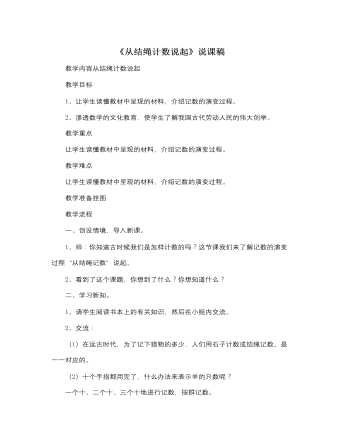
北师大版小学数学四年级上册《从结绳计数说起》说课稿
教学内容从结绳计数说起教学目标1、让学生读懂教材中呈现的材料,介绍记数的演变过程。2、渗透数学的文化教育,使学生了解我国古代劳动人民的伟大创举。教学重点让学生读懂教材中呈现的材料,介绍记数的演变过程。教学难点让学生读懂教材中呈现的材料,介绍记数的演变过程。教学准备挂图教学流程一、创设情境,导入新课。1、师:你知道古时候我们是怎样计数的吗?这节课我们来了解记数的演变过程“从结绳记数”说起。2、看到了这个课题,你想到了什么?你想知道什么?二、学习新知。1、请学生阅读书本上的有关知识,然后在小组内交流。2、交流:(1)在远古时代,为了记下猎物的多少,人们用石子计数或结绳记数。是一一对应的。
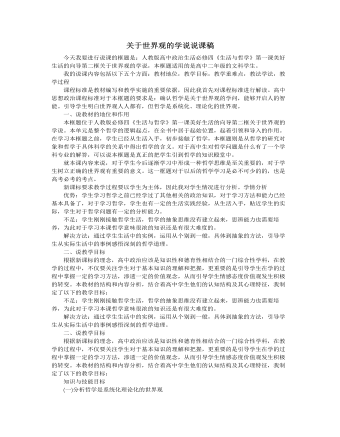
人教版高中政治必修4关于世界观的学说说课稿(一)
3、课堂小结,强化认识。(2—3分钟)通过总结本课的知识,简单的用三个概念三个关系,简明扼要的总结出本节课的知识,突出本框题的重难点。其中重点给学生梳理一下哲学的含义,使学生在学习的最后对于哲学有一个全面而准确的理解,强化学生对于哲学的认识。4、课堂练习针对高中学生初步接触哲学,运用哲学思维来分析哲学问题的能力还需要今后的培养,我进行了分层的方式来设计习题,这样设计一方面符合学生认知的能力,由简单到困难,一步步的深入,另一方面,在练习的过程中,也可以使学生巩固基础知识,使学有余力的学生继续提高,充分考虑到学生的实际情况。5、板书设计为了强化教学效果,我会在授课的过程中适时的书写板书,我的板书设计总的来说是以简洁明了的形式展示,便于学生一目了然的把握本节课的重难点,也可以建立知识间的联系,便于学生形成完整的知识体系。

